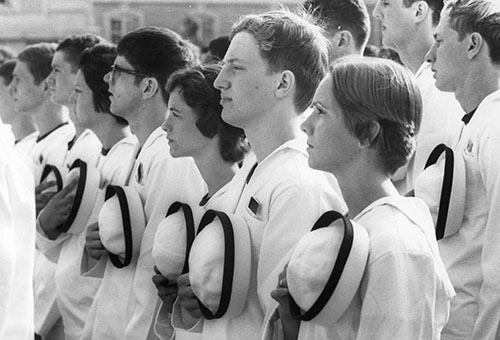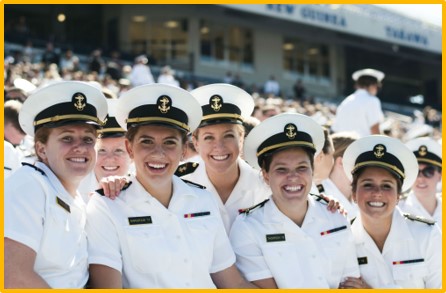Breaking In: 40 years of USNA women in service
By LCDR Lauren (St. Pierre-Hetz) Wilson ’09, USN
“It’s a great place to be from, but not a great place to be at!” goes the old adage that is frequently muttered amongst current and former midshipmen alike as they reflect on their time at Mother B. It’s not a secret that successfully completing four years at the Naval Academy is a significant challenge…and necessarily so. But how many of us had a harder time than our peers specifically because of our gender?
 My local Naval Academy Alumni Association chapter in Raleigh, NC recently hosted a virtual conference to recognize 40 years since the first class of women graduated the Academy. As I naively prepared questions to help facilitate our discussion, I researched interesting facts about the classes of 1980 and 2020 to show how far women have come in 40 years. I came ready to share how many women applied, graduated, and what majors and service selections were available to the first classes. I was excited to hear about their experiences and to share some common frustrations and stories of my own. I was not prepared for the harsh tribulations that would be shared with us. Joining me on the conference call were Major Tara Sutcliffe ’09, USMC, Kelly Jones Baker ‘09SWO(N), Christopher Perrien ‘74, Jenifer Clement ‘81, and Elizabeth Durham Hallinan ‘80.
My local Naval Academy Alumni Association chapter in Raleigh, NC recently hosted a virtual conference to recognize 40 years since the first class of women graduated the Academy. As I naively prepared questions to help facilitate our discussion, I researched interesting facts about the classes of 1980 and 2020 to show how far women have come in 40 years. I came ready to share how many women applied, graduated, and what majors and service selections were available to the first classes. I was excited to hear about their experiences and to share some common frustrations and stories of my own. I was not prepared for the harsh tribulations that would be shared with us. Joining me on the conference call were Major Tara Sutcliffe ’09, USMC, Kelly Jones Baker ‘09SWO(N), Christopher Perrien ‘74, Jenifer Clement ‘81, and Elizabeth Durham Hallinan ‘80.
Before the call, I suppose I had imagined how tough it must have been for the first classes of women to break into the ranks of our beloved alma mater. Change is hard, and in general, people resist it. As it turns out, I realized I didn’t have a clue as to what a typical day in the life of a female midshipman looked like when facing constant friction from men up and down the chain of command. These women were targeted and relentlessly bullied in a campaign to expressly weed them out because of their gender.
Jen Clement had a keen interest in engineering and the nuclear navy in particular. She was the only woman in her marine engineering major, which she describes as “nuclear engineering with an emphasis on propulsion.” Former Superintendent Vice Admiral William P. Lawrence ’51, USN (Ret.) was very supportive of Jen attempting to break into the nuclear power community. He put her on the list to interview. Admiral Hyman G. Rickover ’22, USN (Ret.) had other ideas, however. He personally called Admiral Lawrence and said, “If she’s on that bus, I’ll turn them all around and no one gets an interview!”
As Jen continued to describe Admiral Rickover’s colorful condemnation of her I thought, “oh man, you dodged a bullet there!”...as those of us who have been through the nuclear power training pipeline are known to jest. But the soberness of being completely denied the opportunity quickly removed the smirk from my face. I couldn’t imagine the frustration and disappointment she must have felt.
After Jen finished her story, I didn’t know what to say. I simply told her I was sorry that had happened to her. I wasn’t sure if there was any redemption in the fact that I was able to service select nuclear power “so easily” or if she would resent that. I felt equally apologetic and eager to share how much things had changed for the better as some sort of consolation prize. Would she celebrate that change, or feel bitter about having been denied the same opportunity because of her gender? Jen would have been completely justified either way. My path was so different from hers. Not only did I have the option to select nuclear power, I had a wonderful female nuke SWO mentor from the class of 2001 to help me along the way.
Unfazed and undeterred, Jen went on to blaze a different path as one of the early female Engineering Duty Officers. She graduated top of her class at the nuclear ship superintendent school in Bremerton, and would eventually lead an entire overhaul of a nuclear submarine as ship superintendent at Norfolk Naval Shipyard. Jen’s only regret is that when the overhaul was complete she wasn’t able to get underway with the submarine for sea trials. Women were not permitted to leave the pier at the time. Jen’s attitude is remarkable given the resistance she continually faced, “The Navy did the most they could for me at the time.”
 As Naval Academy grads, we owe the first classes of women a debt of gratitude. It’s unacceptable that an already highly selective and competitive path to serving your country was made even more difficult by a resistance to change. You faced unspeakable harassment and hazing because of your gender. I am honored to have this opportunity to document the strength and tenacity of all the female midshipmen during such a difficult period of change. Thank you all in a special way from those of us who have directly benefited from policies and changes accelerated by you refusing to take “no” for an answer. I acknowledge there are still challenges that women in service today are facing, but I am so grateful that many of our nation’s policies eventually caught up with the capacity of women serving.
As Naval Academy grads, we owe the first classes of women a debt of gratitude. It’s unacceptable that an already highly selective and competitive path to serving your country was made even more difficult by a resistance to change. You faced unspeakable harassment and hazing because of your gender. I am honored to have this opportunity to document the strength and tenacity of all the female midshipmen during such a difficult period of change. Thank you all in a special way from those of us who have directly benefited from policies and changes accelerated by you refusing to take “no” for an answer. I acknowledge there are still challenges that women in service today are facing, but I am so grateful that many of our nation’s policies eventually caught up with the capacity of women serving.
Don’t take my word for it. Let’s look at some current stats from Navy Personnel Command. At first I thought it was simply an interesting anecdote that on our small virtual call, Jen had been denied the opportunity to serve in the same nuclear Navy that two of the other women on the call (Kelly, myself) had successful careers in as nuke SWOs. Today, women make up 20 percent of the officer corps in the Navy. Looking specifically at the nuclear navy, the percentage of women jumps to 27 percent in the SWO(N) community alone. That doesn’t even include the 5 percent of women that make up the submarine community; a community only opened to women in 2011. All I have to say to that is, “Jen, you were on to something. Women really do have a knack for this nuke thing.”
I learned so much more on our conference call that night than the original questions I sought answers to. Tremendous growth and understanding can come from having these conversations. I urge our alumni (especially women that have served in recent years) to reach out to women from the early classes. It’s so easy to pick up Shipmate, find someone on Facebook or LinkedIn and find common ground. Connect with someone you may have never met in person and start the conversation. My classmates on the call with me that night, Kelly and Tara, texted me afterwards as they reflected on what they’d just experienced.
"It was amazing to hear their stories. I'm still thinking about them. I wasn't quite sure how to best chime in because I felt my story was inconsequential compared to theirs, but I wanted to thank them because I feel like so many of the opportunities I had both at the Naval Academy and in the fleet would not have been possible without their service first. And of course, I look for ways to pay it forward to female JOs and prospective USNA students when I can. Really grateful!"
-Major Tara Sutcliffe ‘09, USMC
"I so enjoyed last night's discussion and hearing Jen and Liz's stories of being in the first classes of women. I'm feeling extra motivated today at work and I think last night's session may be the cause of that. It forced me to pause and think about the unique experiences we all had at a very early time in our adult lives and how my own experiences at USNA really shaped who I am today"
-Kelly Jones Baker ‘09, SWO(N)
Sharing our stories unites us and can inspire us to action. It sparks critical questions that lead to self-reflection.
“Where is there still room for improvement in matters of gender, race, sexual orientation?” “How can we address these disparities?”
“Must we take a closer look at the policies of our alma mater—our Navy and Marine Corps—the biases of our own hearts?”
The generation of women who came before me broke barriers. Through their courage and determination, they made the Naval Academy a place where women could be challenged and tested at the same level as their male counterparts.
My daughter, Maddie, is almost 3-years-old. At her baby shower before she was born, my mom had custom chocolate bar wrappers bedecked in anchors (as any shameless Navy grad would have) made as favors for guests that said “Ahoy! USNA Class of 2038!”, as if the poor kid with parents who are both Navy alumni, would have no choice in the matter. 2038 seems so far from now, but I’m sure it will be here before my husband and I are ready.
Maddie may not want to follow in her parents’ footsteps, and that’s okay. But thanks to the generations of women who came before her, not only is applying to the Naval Academy an option, it has grown into a place where women can be challenged and tested at the same level as their male counterparts. I’ve always been proud that the yard is a place without shortcuts. It must continue to strive to be a place without limitations.